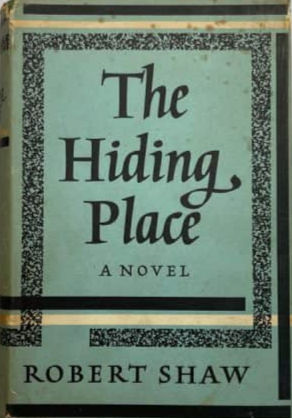
.com

Estd. 2020
Approved by the Shaw Family



1960
Two British airmen, Wilson and Connolly, are incarcerated in a cellar in Bonn: their captor, Corporal Frick, has kept them there ever since the day when he hid them from an infuriated mob and the Gestapo after a raid. He treats his prisoners with kindness, but he has never dared to let them go. Wilson has discovered in himself a talent for writing: Connolly has spent the time brooding about his loved wife and trying to plan an escape. One morning the prisoners realize that al lis not well with their jailer, and when, driven by ill-health, Corporal Frick is compelled to release them, the irony of their imprisonment and escape suddenly dawns on them.
the hiding place
The Hiding Place opens with Hans Frick putting on his Nazi party uniform, preparing his breakfast, and taking a tray with meals down to the two RAF airmen imprisoned in his cellar. While they eat, he tells them a story about a British bomber shot down outside Karlsruhe. The crew, having been rescued after parachuting into the Rhine, were summarily shot by the local Gauleiter. He then heads upstairs, changes out of his uniform and into a suit, and bicycles in to work.
“The date was June the twelfth, nineteen fifty-two.”
After World War Two, the Soviet Union was returning its last surviving German prisoners from World War Two. For several decades stories would appear from time to time of Japanese soldiers who emerged from the jungles of Pacific islands after hiding out for years, unaware the war had ended. But in The Hiding Place, Robert Shaw imagines the plight of two British airmen held in isolation, ignorant of the outside world aside from the stories of victories on the Russian front, amazing new German weapons, and the continuing futile attempts by Allied bombers to attack Germany.
This is not, however, an alternate history like Philip K. Dick's 'The Man in the High Castle". Instead, it’s a tightly-focused study of the psychology of prisoners and their jailer that anticipates by over a decade the phenomenon known as Stockholm syndrome. Connolly and Wilson, having bailed out when their Lancaster bomber was hit on a raid over Bonn, are taken prisoner by Frick, a civil defense auxiliary. To keep them from being lynched by an angry mob, he ushers them to his nearby house and locks them in the bomb shelter that’s been built in his basement. Thanks to his late mother’s fears about being buried alive, the shelter is extremely strong and completely soundproofed.
As the first hours pass, however, he realizes the quandary he's in: he cannot take the men to the Gestapo without questions about the delay; neither can he set them free. He soon decides the only solution is to keep them prisoner in his house. And so he enters upon a fiction that, once started, he can’t figure out how to end.
Shaw manages with remarkable success in convincing the reader that Frick could continue to convince his prisoners that his fiction is their reality. In part he does this by careful attention to the necessary practical details, but more is the result of his understanding of how prolonged captivity, particularly in relative comfort compared to what the typical Allied POW in Germany could expect, erodes the will to resist.
Wilson endures their confinement better than Connolly. A lawyer in civilian life, he early on convinced Frick to supply pencil and paper so he could practice translating remembered English texts into German. When his memory ran out, his imagination took over. Gradually, Connolly becomes “aware how much Wilson was changing — how much he was beginning to enjoy writing — how much there seemed for him to do.”
Eventually and quite by accident Wilson and Connolly do escape, and in some ways what happens next forms the most interesting part of the book. Interesting because the reader wonders where Shaw will take the story. After all, the men think the war is still going on, that they are in the midst of enemy territory. So, even after getting away from Frick, Frick’s fiction remains with them: they are, indeed, actively resisting being set straight.
Frick also struggles to adapt to his new reality after the escape, for he has become as emotionally dependent upon them as they have been physically dependent upon him. Despite the inhumanity of Frick’s actions, Shaw makes him seem sympathetic in the end. The Hiding Place manages to be both thrilling and tender and despite the very specific conditions upon which the story is premised — also somewhat timeless. It could almost as easily have been set during the American Civil War or on another planet as science fiction.
The Hiding Place was twice staged as a television play: once in the U.K. with Shaw himself, along with Sean Connery, as the airmen, and once in the U.S. with James Mason as Frick and Richard Basehart and Trevor Howard as Wilson and Connolly. Unfortunately, neither one of the productions received positive reviews.
Then, Gottfried Reinhardt, son of the legendary theater director Max Reinhardt, decided to turn it into a comedy, Situation Hopeless...but Not Serious with Alec Guinness as the jailer and Mike Connors and Robert Redford as the airmen, now Americans. One IMDB reviewer wrote that the movie “was sheer torture to watch”; another, that it was “the strangest Alec Guinness film out there.”
The Hiding Place was Robert Shaw’s first novel. And though he’s now primarily remembered as an actor, he wrote a total of five novels.



